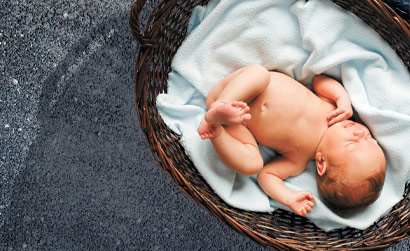
 by Shelly Feuer Domash, Jaclyn Gallucci and Christopher Twarowski
by Shelly Feuer Domash, Jaclyn Gallucci and Christopher Twarowski
Baby Angelica was born in the early morning hours of July 16, 1997. She was 6 pounds, 19.5 inches long. Workers found her in the first stall of the first floor women’s restroom at Nassau’s First District Courthouse in Hempstead.
The newborn had been left in the toilet and covered in a pile of wet toilet paper. Her official cause of death is listed as “drowning—unattended delivery into toilet,” according to the Nassau County Medical Examiner’s Office, and her demise remains classified as a homicide. Angelica’s mother has never been found.
Upon arriving at the scene and observing the child’s lifeless body, Nassau County Police Department Paramedic Timothy Jaccard wept. Within a few weeks, he responded to several more heartbreaking calls that would ultimately change the course of his life: A newborn not breathing, left in a bag on the side of an office building in Albertson. A baby shoved into a plastic bag and unearthed by a dog. Another baby, not breathing, found in a recycling bin in Cedarhurst.
It was all too much, even for a seasoned medical technician with 37 years of experience. Jaccard knew he had to do something. He researched infanticide—the homicide of an infant—and discovered that a woman could not legally give birth to a baby and then leave that baby with no intent to return. In fact, she could be charged with abandonment, endangering the welfare of a child and child neglect, all felony charges that could result in at least a four-year prison term. He also discovered that in a 10-month period in just three U.S. cities there had been 41 cases of neonaticide—the killing of a baby in the first 24 hours of life: 16 in New York, 13 in Houston, 12 in Mobile, Ala.
Thus began what would be his life’s mission: to save as many children as he could from succumbing to these desperate acts—or their birth parents, who out of panic may resort to murder.
In 1998, Jaccard founded the Long Island-based nonprofit AMT (short for Ambulance Medical Technicians) Children of Hope Foundation/Baby Safe Haven out of a need to pay for the burial of unwanted children; that need has evolved, however, with the Foundation’s primary focus being the prevention of these tragedies.
The group operates three national 24/7 emergency hotlines—out of New York, Ohio and Massachusetts—to assist pregnant women in crisis who have nowhere else to turn. AMT Children of Hope/Baby Safe Haven raises awareness about Safe Haven laws, counsels expecting parents, provides support to prepare them for raising their child, or helps them make adoption plans.
In 2006, he founded the Washington, D.C.-based nonprofit National Safe Haven Alliance. He is the president of both.
The lifelong Wantagh resident’s efforts have resulted in the establishment and nationwide adoption of newborn abandonment laws—known as the Abandoned Infant Protection Act in New York, also referred to as “Baby Moses” or “Safe Haven” laws across the country—which authorize designated emergency infant care providers to take possession of a child between 24 hours to 60 days old or younger (depending upon the state) from the child’s parent if the parent doesn’t have the intention of returning for the child. The legislation also protects parents from criminal prosecution when they deliver an unharmed child to said providers.
“Safe Havens” are designated public places, such as police stations, fire houses and hospitals. New York State passed its version in 2000, becoming the 12th state to do so.
It has been a long road, but since 2008, every state and district in the country now has a law, Jaccard tells the Press. Most have the same version, but New York and South Carolina are the only two that allow the mother to turn the baby over to any responsible party willing to accept the newborn and call the proper authorities to have the baby transported to the hospital.
Just a day after retiring from Nassau County police in August, Jaccard, 60, was appointed the first Safe Haven Coordinator in the country—equivalent to a captain position in the police department. Recently, Nassau became the county first in the nation to install Safe Haven demarcations beneath all blue-and-white hospital signs and designate ambulances as official drop-off sites, thanks to Jaccard.
Yet despite Children of Hope/Baby Safe Haven’s nationwide reach [it’s been featured on national talk shows] and the passage of Safe Haven laws more than a decade ago, Nassau, Suffolk and other municipalities across the country are still seeing cases of infanticide and neonaticide; the most recent here on Long Island being the grim discovery in January of a crushed and frozen newborn dumped at a Yaphank recycling center.
“Placing the baby in the ground at the cemetery is the toughest part, because it is final,” Jaccard tells the Press. “You stand there and look down in the grave and know the child could have been here running around, playing in the grass and having a good time if the mother had just reached out to us.”

AMT Children of Hope/Baby Safe Haven President Timothy Jaccard stands in front of one of his organization's nine mobile billboard trailers.
Rescue Me
On Jan. 4, at 9:30 a.m., an employee of the Winter Brothers waste transfer station on Old Dock Road in Yaphank discovered a newborn little boy crushed amid the garbage. The baby was pronounced dead at 10 a.m.
As the AMT Children of Hope Foundation does each time a slain newborn or infant is discovered, the group took legal custody and made arrangements for his dignified burial at a plot within Holy Rood Cemetery in Westbury, called the Island of Hope.
Six bagpipes played. Twenty-four American flags were flown. Flowers adorned the casket. A motorcade including fire trucks, ambulances, escorts and three busloads of mourners accompanied the baby to his final resting place all the way from the Church of St. Sylvester in Medford, despite the fury of a “horrendous storm,” says Jaccard. Members and volunteers in attendance wore full dress uniforms; Children of Hope/Baby Safe Haven consists of more than 160 volunteers, including all Nassau County police medics, as well as doctors, lawyers, civilians, health care workers and obstetric clinics. More than 200 people were in attendance, according to Jaccard.
There, alongside 91 other victims who met similar fates, Thomas John Hope [all children buried by the Foundation are given the last name Hope; there are 108 who have been buried in all] was laid to rest with a hero’s burial ceremony, as are all those who have died by abandonment and homicide. The exception—numbering about two dozen, the children of mothers in the care of the program who died of natural causes—were given what Jaccard calls “silent funerals” at the site.



